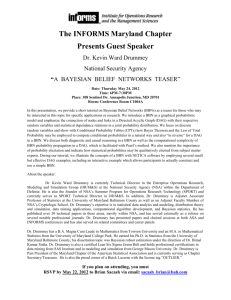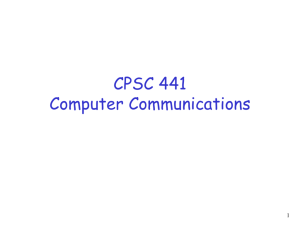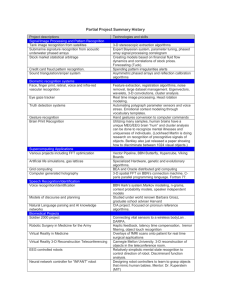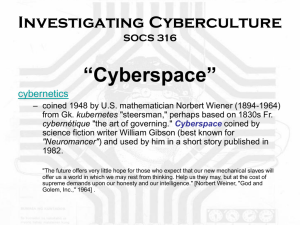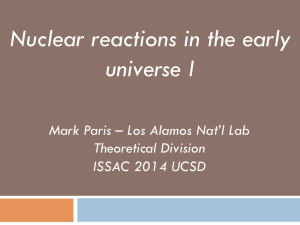class notes
advertisement
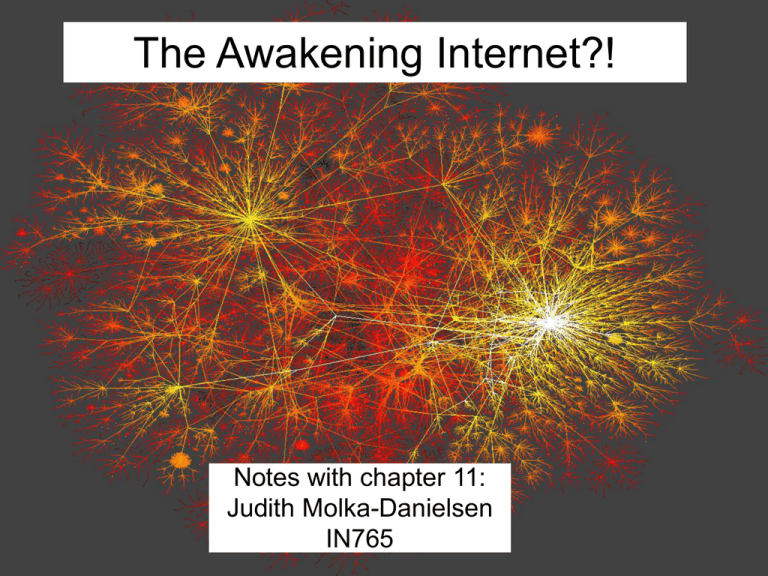
The Awakening Internet?! Notes with chapter 11: Judith Molka-Danielsen IN765 Paul Baran 1 -Worked for RAND from 1959. -Must design a network to survive nuclear attacks. -Vulnerabilities were in the topology -1964 three topology types -suggests Packet Switching - Military and AT&T reject the idea. http://www.ibiblio.org/pioneers/baran.html Early History of the ARPANET • 1958Eisenhower forms the ARPA (Advance Research Projects Agency) in response to the USSR's launch of the Sputnik. • 1966 December: ARPA Computer Network (ARPANET) project begins. • 1967 April: Suggested that the ARPANET utilize a separate computer between the host and the network. This computer would perform the packet switching/routing. This separate computer dubbed the Interface Message Processor or IMP. • 1968 December: Contract to build the IMPs is won by Bolt Beranek and Newman Inc. (BBN) • 1969 April: First specification for Host to IMP communication (BBN report 1822) is released. The discussion of the Host to Host Protocol begins with RFC 1. The Network Working Group (NWG) forms to deal with the task of Host-Host layer communication protocols. September: The first IMP is delivered and connected to a Sigma 7 computer at UCLA. This IMP constitutes the first node of the ARPANET. October: The second node of the ARPANET is installed at Stanford Research Institute (SRI). The IMP is connected to an SDS 940 Computer. The first message is sent across the network and received. November: The third node of the ARPANET is installed at UCSB. December: The fourth node of the ARPANET is installed at The University of Utah. J.C.R. Licklider -He worked for several years at ARPA where he set the stage for the creation of the ARPANET. -He also worked at Bolt Beranek and Newman (BBN) from 1957 to 1968, where he acquired 2 computers for BBN, that would be developed into the first computers connected on the ARPANET. -From 1950 at MIT he had worked on a Cold War project called SAGE designed to create computer-based air defense systems against Soviet bombers. Computing was batch processing and took a lot of time. In 1960, Licklider published his groundbreaking work "Man Computer Symbiosis." , and much of his work has lead to the developments in Interactive processing. Mapping the Internet 2 • Bill Cheswick and Hal Burch produce complex images of the Internet (lines and routers) in 2000. (peacockmaps.com) • Internet Mapping Project (http://research.lumeta.com/ches/map/inde x.html ) • John Quarterman (http://www.quarterman.com/jsq/ ) BBN 3 • Bolt, Beranek and Newman (now called BBN Technologies) is a technology company that provides research and development services. BBN is based in Cambridge, Massachusetts. It is also a defense contractor. • Founded in 1947 by Leo Beranek and Richard Bolt, both professors at MIT, with Bolt's former student Robert Newman, Bolt, Beranek and Newman started life as an acoustical consulting company. Their first contract was consultation for the design of the acoustics of the United Nations Assembly Hall in New York. • Work in acoustics then required substantial calculations which led to an interest and later business opportunities in computing. Although BBN still has a substantial interest in acoustics, it is now better known for its activities in computing. • Some of BBN's developments of note are the implementation and operation of the ARPANET, the first person-to-person network email sent, the invention of the @ sign in an email address, the first router and the development of the TCP protocol. • BBN creates large multi-processor systems for warfare simulation for the U.S. Navy. • http://www.bbn.com Internet as a complex evolving system… • Ray Tomlinson (BBN) modified ftp so it could carry email. • Internet was not designed for applications (like email or web, they came as afterthoughts.) • Internet is more like a cell than a computer processor chip. 4 We must understand the topology • Vern Paxon and Sally Floyd - 1997 say we must know the topology to understand how the parts interact. • Faloutsos brothers – 1999 – discover the placement of routers follows a power law. But also both physical hardware and logical links follow the same power law. Where do you place links? 5 • Where one obtains the most bandwidth for the given costs • Total bandwidth is a factor of the size of the router. • Line costs are a factor of distance to the connecting party. • Total value = BW given the line costs. Where do you place the routers? • There seems to be a correlation between routers and population density. • The routers on the Internet form a selfsimilar fractal set. Spatial Distributions Router density Population density Spatial Distribution of Routers Fractal set Box counting: N(l) No. of boxes of size l that contain routers N(l) ~ l -Df Df=1.5 Factors in modeling the Internet 1. 2. 3. 4. Growth Preferential attachment Distance dependence Underlying fractal structure Vulnerabilities of the Topology 6 • MAI Network Services – 1997 – sent an incorrect update to routing tables, the error was sent on to others, resulted in all Internet traffic was temporarily directed to themselves. Example of a cascading error. • Peter H. Salus and John S. Quarterman paper on disruptions and emergencies on the Internet. Is the Internet one Computer? 7 • Can any computer on the Internet do computation on your own behalf? (Yes, by using the commucation protocols in a way that they were not designed. i.e. many viruses.) Term “parasitic computing” emerges. • Jay Brockman says faster processors, fasters lines, sharing processing..can lead to intelligent being (?, a bit much) SETI is a model for voluntary sharing. • Someday you will get an answer on your browser and not know where it came from. (How is this implementable?) The Semantic Web 8 • More than an application, the future of the Internet. • Millions of sensor and input devices feeding information into the Internet is not enough for the Internet to become ”self-aware”. • New technologies and protocol platforms are being developed. Building blocks include XML based languages and ontologies. Taxonomy using networks A: Archaea B: Bacteria E: Eukaryotes • • • • • • • • • • BBN Job Title Senior Software Systems Engineer/Researcher, Decisions and Technologies ; BBN's Arlington, VA office Job Summary qualified person will lead efforts to acquire and conduct funded technology research and development activities in emerging information technologies. Initial focus will be in helping BBN maintain its lead and momentum in the development and standardization of infrastructure, tools and services for the Semantic Web, the next generation Internet. Successful candidates will lead one or more projects, and provide oversight (as needed) to other projects within the department. These projects may be sponsored by the Department of Defense, other Federal Government departments or various commercial organizations. (…cut some) Minimum Requirements: 10 yrs experience in software/systems design & development; 3 yrs of task leadership; 3 yrs of JAVA programming; 3 yrs of webbased application development; Experience directing research efforts, typically as a Principal Investigator; Demonstrated skills in proposal writing and technical editing skills, including task estimation, proposal costing and budgeting; Polished presentation skills; In depth understanding of system engineering and development methodologies; MS in computer science, mathematics, electrical engineering, or a related degree; A DoD security clearance (or the ability to obtain one ? U.S. citizenship) Desired Qualifications: Experience with emerging Semantic Web infrastructures, tools, services, or ontologies (DAML/OWL/RDF) Familiarity with data base schema and structures, and techniques used to access data base contents Expertise in E-business technologies and practices Research expertise in some area of computer/network security A track history of innovative idea generation Ph.D. in Computer Science or related engineering field

